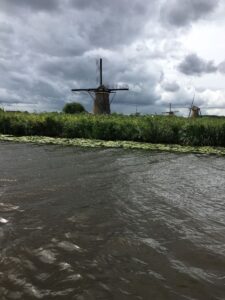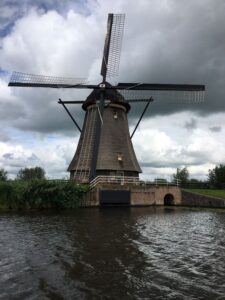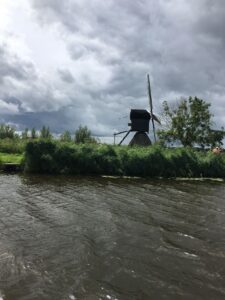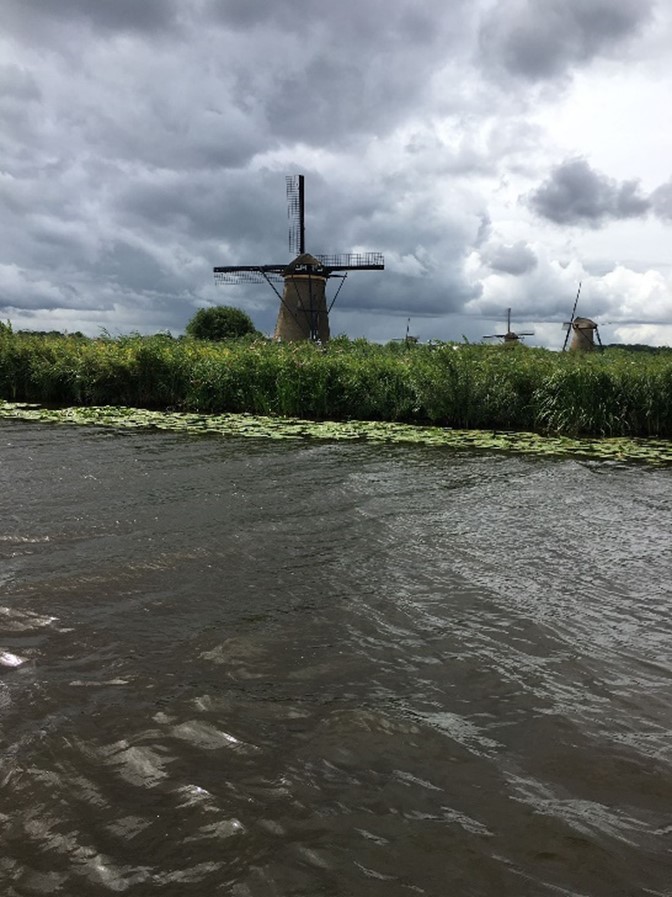Dutch lessons on community-based water management

The Netherlands. Located in the north of Europe, the country is known for its low-lying land. A quarter of the Netherlands lies below sea level, making it highly prone to flooding as sea level rises and extreme weather events such as heavy rain become increasingly common in the face of climate change. As countries across the world try and grapple with challenges of supplying the one in four people globally who lack access to safely managed drinking water in low- and middle-income countries at the same time as trying to identify solutions for climate-resilient WASH, I decided to pay a visit to the Netherlands to see what I could learn. I reflect on my trip to the Kinderdijk windmills to explore how we can learn lessons from the Dutch to address water management challenges in the future at a community level.
Kinderdijk: keeping the water at bay for centuries

After catching a boat from Rotterdam to Kinderdijk in early August 2023, the large sails which characterise the no fewer than 19 windmills scattered along the 18th Century canal system I was sailing through came into view. The wooden Overwaard windmills to the left of the main waterway were built as early as the 16tth Century with the Blokker windmill dating back to 1540, followed by the construction of the mills at the Nederwaard dating back to 1738.

As I learned earlier in the year on my travels in India to the Adalaj stepwells, WASH infrastructure from the past including the centuries-old windmills at this UNESCO World Heritage Site have much to teach us about water management. The windmills were built amongst a network of waterways and reservoirs, creating a system which drained the land and enabled the development of human settlements and agricultural communities. This area of the Netherlands was once a peat bog, which was initially kept dry by the construction of dykes (or embankments) and canals by the early settlers.
The water has been kept out of the low-lying fertile land, or polders, known as Alblasserwaard, by the sophisticated system of windmills at Kinderdijk, which lies two metres below sea level. The windmills were designed to act as machines which could drain the polders. Mechanical wheels within the mills are used to move water quickly and efficiently, by harnessing the power of the wind to move water from the lower basins to the higher basins of the River Lek around Kinderdijk, to create an irrigation system that spans a wide area. The mills use wind to power a pumping device with a scoop wheel at the end by transferring energy using beams, shafts, and gears. The lower mills pump water into the lower basins, which is then pumped by the middle mills into an intermediate basin, before the upper mills pump the water into waterways, rivers and the sea.
The windmills were later supplemented by steam-powered and then diesel-powered pumping stations. The Dutch have continued to rely on windmills as a key drainage technology, particularly when diesel supply became limited when German troops occupied the Netherlands in World War II.

Lessons for climate resilient community-based water management
Discussions around community-based water management are not new to the WASH sector. To this day, we continue to learn from contexts such as India, where community management of water is seen as a shared responsibility between communities and the state. The Kinderdijk windmill complex exemplifies how communities have been critical to management of water in certain parts of the global North as well.
So, what can be learned from Kinderdijk for community-based water management in low- and middle-income countries?
Collective approaches are needed.
Water management in the low-lying land of the Netherlands has required human intervention to ensure that the mills can maximise the power they can gain from the wind. Millers align the sails that famously characterise the structures with the direction of the wind to operate the pump and to pump as much water as possible from the polders, working together with the pumping station. Without collective efforts to do so, water management would simply be impossible at Kinderdijk. As access to water supply expands across low- and middle-income countries, communities need to work together and involve different members of the community in the process of management. The need for gender- and disability-inclusive approaches has been long called for in service delivery, and this needs to be replicated in community-based management strategies to ensure community collectivisation.
Operation and maintenance of infrastructure remains key.
Whilst new technologies for water supply continue to emerge, they need to be sustained and be able to withstand the inevitable impacts of climate change. In the UK, Victorian-age sewers built over 150 years ago continue to carry London’s sewage, only recently starting to come under strain as the city’s population continues to grow, yet maintenance remains critical. Currently in the UK, the failure to maintain school infrastructure built only 30 years ago is at the forefront of public attention, as school roofs built with collapse-prone reinforced autoclaved aerated concrete (Raac) face closure, disrupting education. The Kinderdijk windmill complex stands strong today due to the dedication of the millers who have lived there throughout its lifespan in maintaining the infrastructure, from the sails to the less visible pumping devices. Infrastructure such as windmills need to continue to function, and long-term maintenance of water infrastructure, whether it be centuries-old or weeks-old, will remain integral to ensuring water security for all in the long term.
Moving forward
Community-based water management processes will continue to be integral to ensuring water security for all. Whilst many of the discussions in the WASH sector are focused on addressing the challenges of the global South, there is much to be learned from the communities who live in the famous windmills of the Netherlands. Let’s look for sustainable solutions to water supply that harness the power of nature and bring communities together for the longer term, and take lessons from Kinderdijk.
Acknowledgement
Thank you to Claire Furlong for the fantastic company on this trip to Kinderdijk, and to Brian Reed for insightful conversations to inform this blog.
